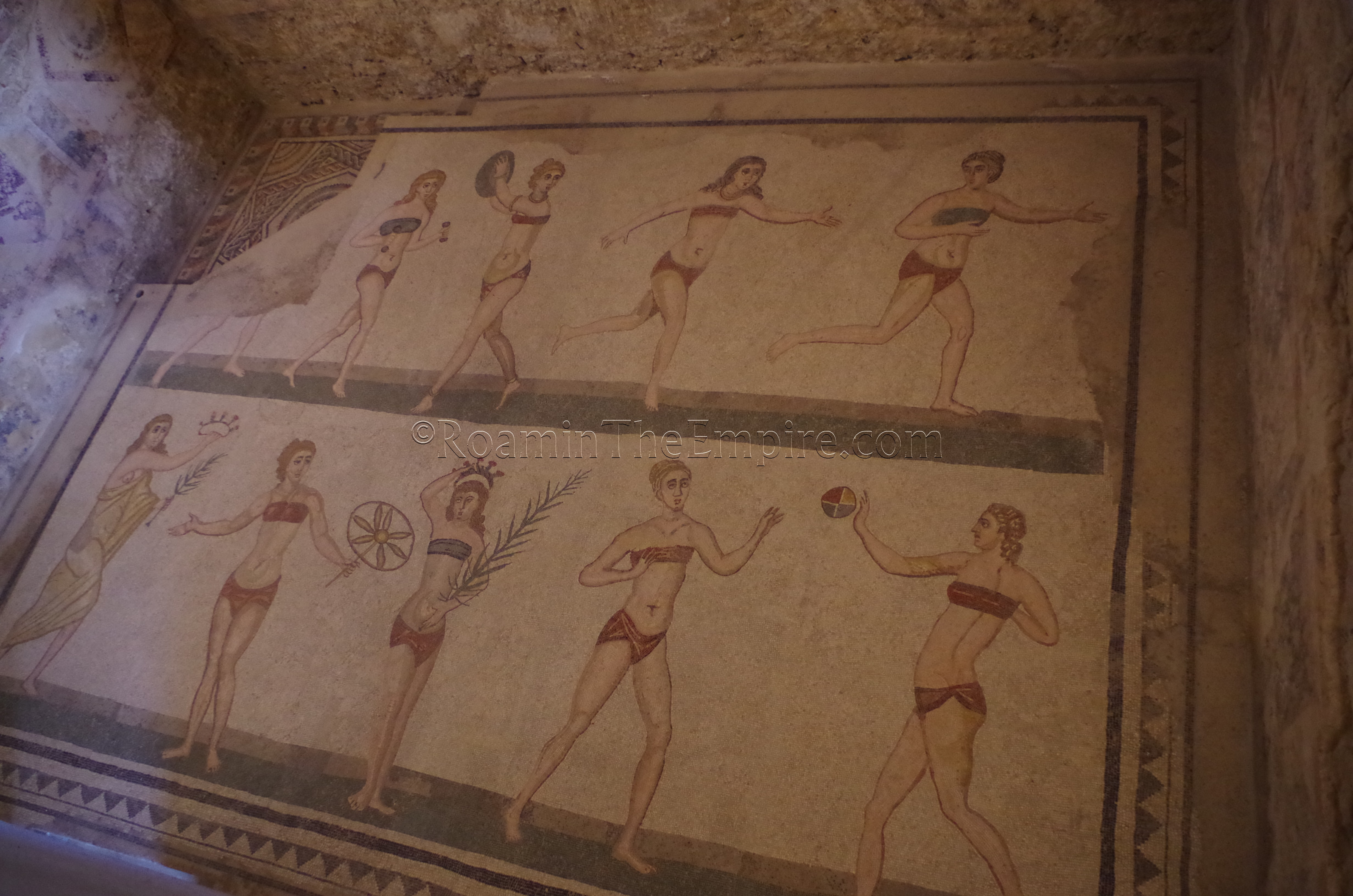
Most Recent Visit: June 2017.
Nestled in a cool valley about three kilometers to the southwest of the modern town of Piazza Armerina is the Villa Romana del Casale, a large and extravagantly decorated villa. A UNESCO World Heritage Site, the villa is world-renowned for the roughly 3,500 square meters of surviving mosaic flooring, though the wall decoration and rest of the villa are certain quite impressive as well. Though the interior of Sicily had declined in importance as far as habitation and urban settlements by the 3rd and 4th centuries CE, the importance of Sicily in grain production eventually led to the creation of great latifundia throughout the interior of the island. It is likely that the Villa Romana del Casale was at the center of one of these large agricultural estates. The Antonine Itinerary mentions a station on the road between Agrigentum and Catana called Philosophiana or Sofiana nearby, and it is likely that the latifundium associated with the villa was known by that name as well.
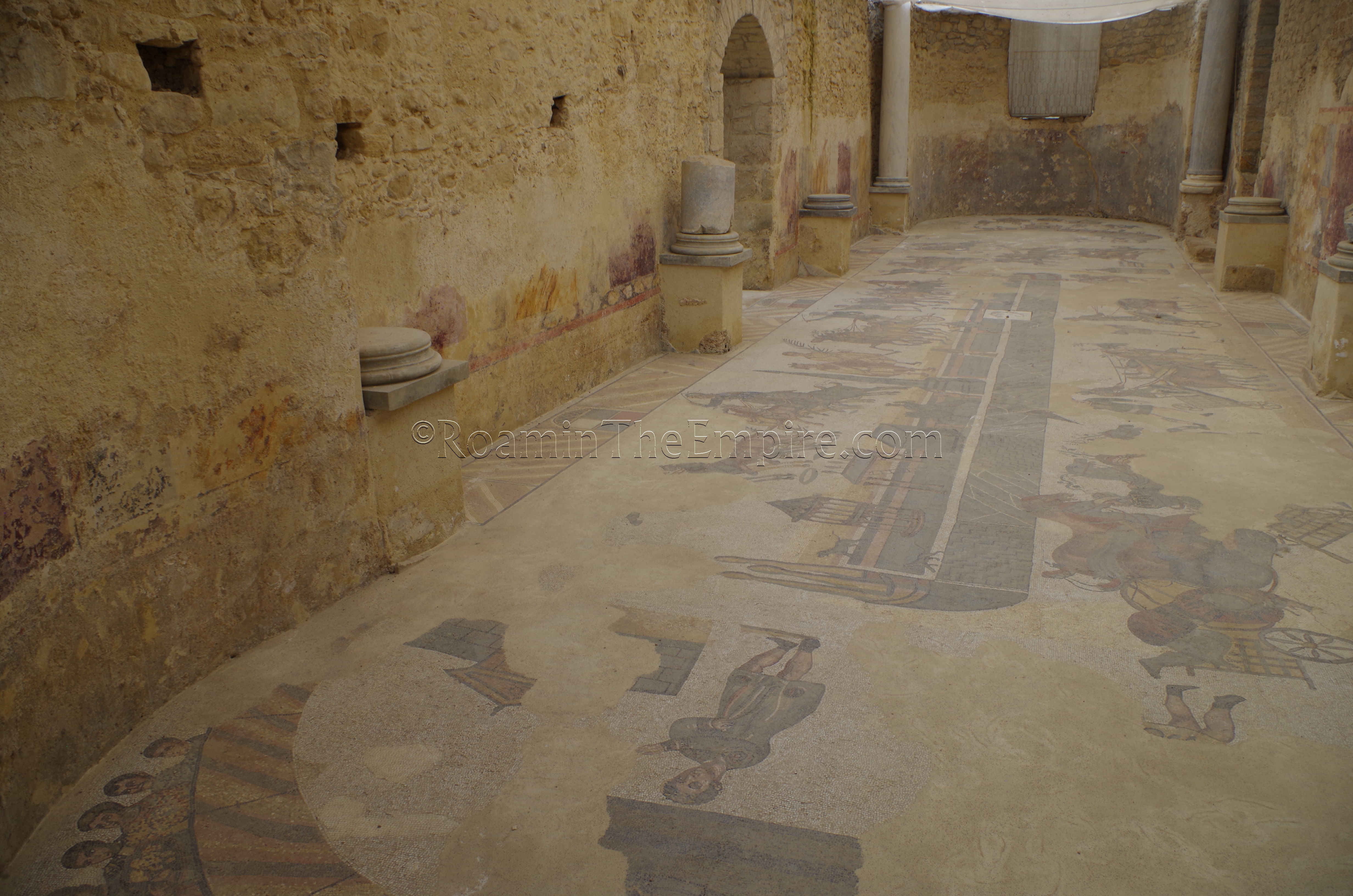
The date of the construction of the villa is a matter of some debate. The villa rests on top of an older, perhaps Augustan in age, villa rustica, but it is generally accepted that the Villa Romana del Casale was constructed in the late 3rd century CE to the middle of the 4th century CE based on various methods of dating. The depiction of the Circus Maximus in one mosaic as having only a single obelisk on the spina has led to the thought that the mosaic, and thus the villa, must have been completed before Constantinus II added another obelisk to the spina in 357 CE. Ceramics in the fill seem to indicate a construction date of no later than the first quarter of the 4th century CE, while coins in the fill indicate a possible terminus post quem of the late 3rd century CE, perhaps no earlier than the reforms of Diocletian in 289 CE. A lack of post-Maximian coins beneath the flooring could be interpreted as a construction period of no later than the reign of Maximian. Stylistic analysis of the mosaics, likely created by artisans from North Africa, would, though difficult, also seem to indicate a date of sometime during the reign of Constantine the Great. The similarity in some of the Corinthian capitals in the villa, to those used in Diocletian’s Palace at Split and the Baths of Diocletian in Rome, lead some to believe they came from the same workshop, operating around 300-310 CE.
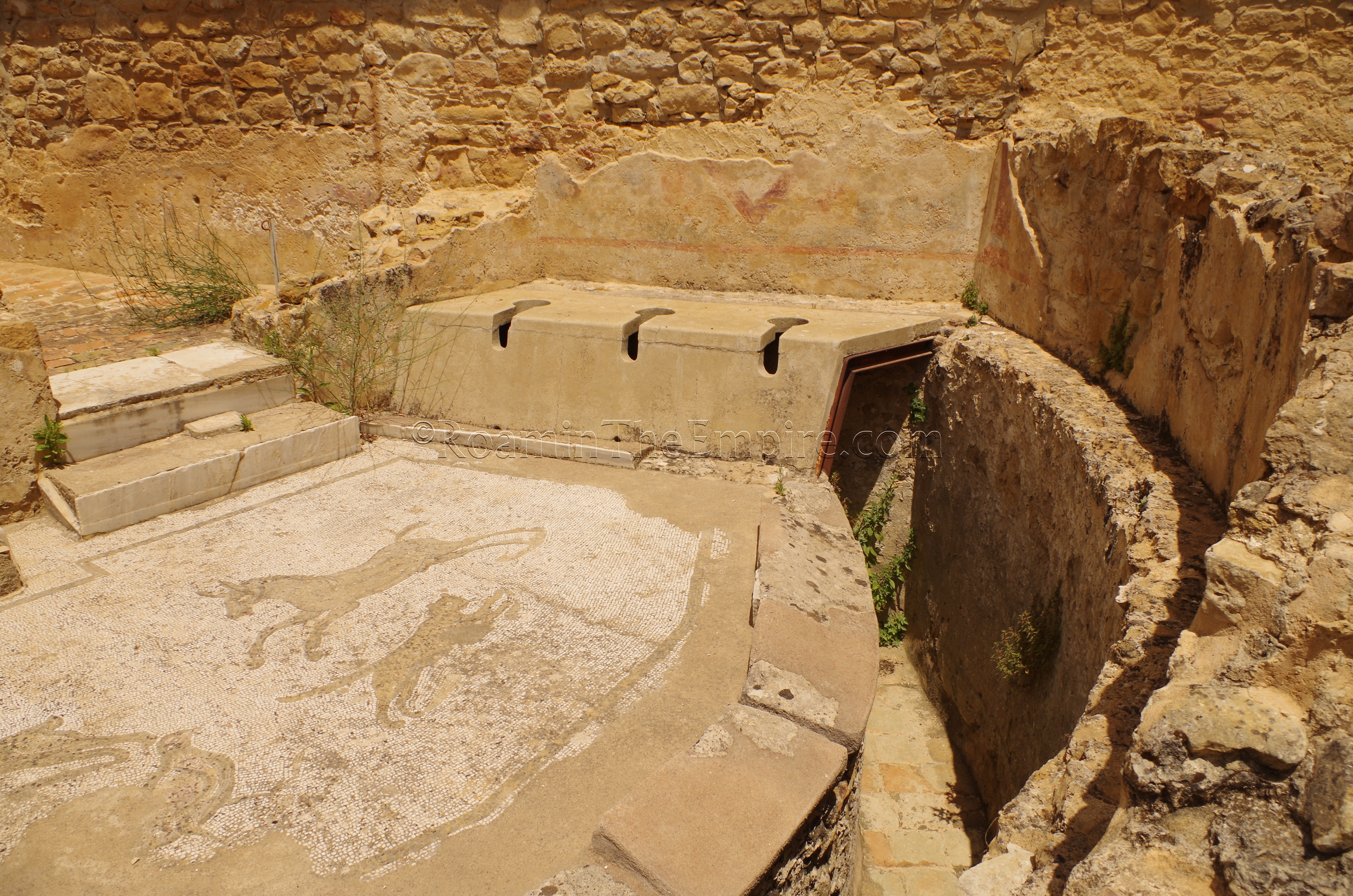
The identity of the owner or owners of the villa is somewhat enigmatic as well, with several theories put forth. The wealth of the villa and the estate would indicate that the owner of the villa was, at the very least, likely of the senatorial class, but perhaps even part of the imperial family. One such theorized owner was Lucius Aradius Valerius Proculus, who among being a consul in 340 CE and twice praefectus urbi of Rome, was also the governor of Sicily from 327 to 331 CE. Another Roman senator linked with the villa is Caeionius Rufius Albinus. Albinus was a consul in 335 CE also a praefectus urbi of Rome from 335 to 337 CE. Other governors of Sicily in the early 4th century CE, Domitius Latronianus and Betitius Perpetuus have been mentioned as possible owners as well. The emperor Maximian and/or his son Maxentius have also been posited as possible owners for the villa. This theory is based on the analysis of some figures in the mosaics being, at the very least, magistrates of the tetrarchy period, or possibly in some cases images of the emperors themselves. The use of imagery related to Hercules through the villa has also been cited as a possible link to the Maximian and Maxentius, who claimed Hercules as a patron of the family. Maximian’s campaigns in North Africa in the last years of the 3rd century CE may have afforded him the need for a nearby retreat from campaigning. The monumentality and hierarchical construction style of the villa have also led to speculation about an imperial connection to the owners.
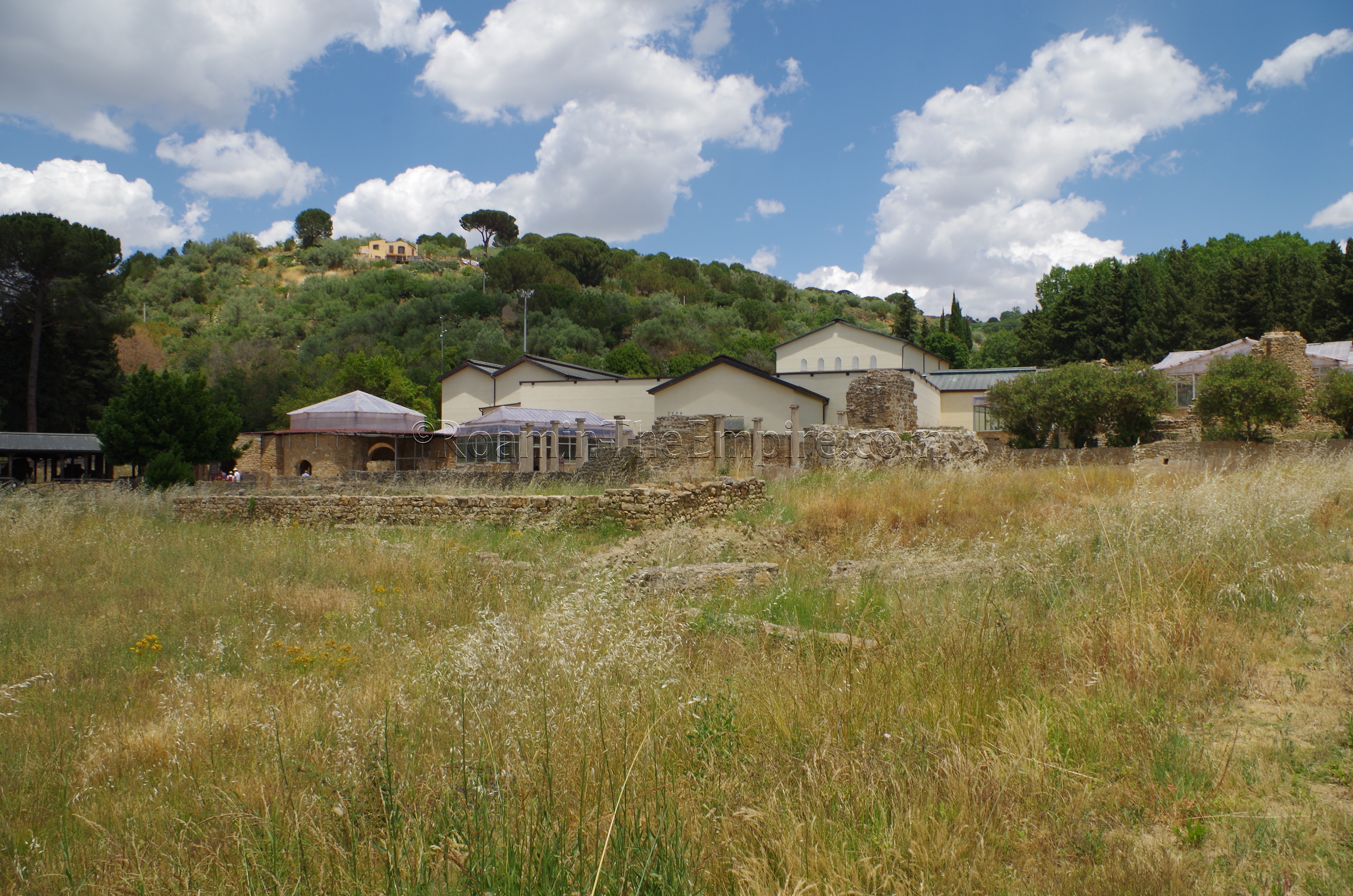
Getting There: For a relatively small city in central Sicily, Piazza Armerina is fairly well connected to the major cities in Sicily. This is probably, in no small part, to the popularity and tourist draw of the villa. From Palermo, SAIS Autolinee runs pretty regular bus service to Piazza Armerina with 5 departures daily during the week and 3 each on Saturday and Sunday (both two and from). The journey takes a little over 2 hours and leaves from near the train station in Palermo and arrives at Piazza Senatore Marescalchi in Piazza Armerina. The price is 12.50 Euros each way or 20.40 Euros round trip. Schedules and details can be found here. From Catania, Interbus runs several departures daily to and from Piazza Armerina. The trip takes between an hour and a half and an hour and forty-five minutes and costs 9.20 Euro each way, or 14.80 Euro roundtrip. Details of that schedule can be found here. From Piazza Armerina, there is a shuttle in the summer that runs from Piazza Senatore Marescalchi to the villa, though outside of the summer months (schedule here), it might be a trickier endeavor. Supposedly the Interbus from Catania runs all the way to and from the villa as part of the route between Catania and Piazza Armerina, though. If driving, signs are not exceptionally helpful or frequent, but I was able to get there with a little intuition and managed not to get lost. There is ample parking at the site.
The Villa Romana del Casale is located at SP90, 94015 Piazza Armerina, EN. Again, it’s a big tourist draw, so it is fairly well signed in the area. From April to October it is open 9:00 to 18:00, and the rest of the year it is open from 9:00 to 16:00. Entrance to the villa is 10 Euros. It also costs to park, but, the fee is very reasonable.

Like Pompeii, the preservation at the villa owes much to a sudden cataclysm of nature for the present state of its decorative elements; in this case a landslide in the 12th century CE that buried the villa in 10 feet of mud until its excavation in the 1950’s. After the fall of the Roman Empire, the villa saw intermittent periods of occupation between then and the villa’s burial in the landslide. On at least two occasions, the villa and its subsequent constructions may have been subject to damaging or destructive events prior to the landslide, but apparently not on a level that destroyed the remaining mosaic. A recent restoration, completed in December of 2012, greatly improved the accessibility as well as the level of protection for the remains of the villa; modern protective roofs now cover the majority of the villa and all of the mosaics.
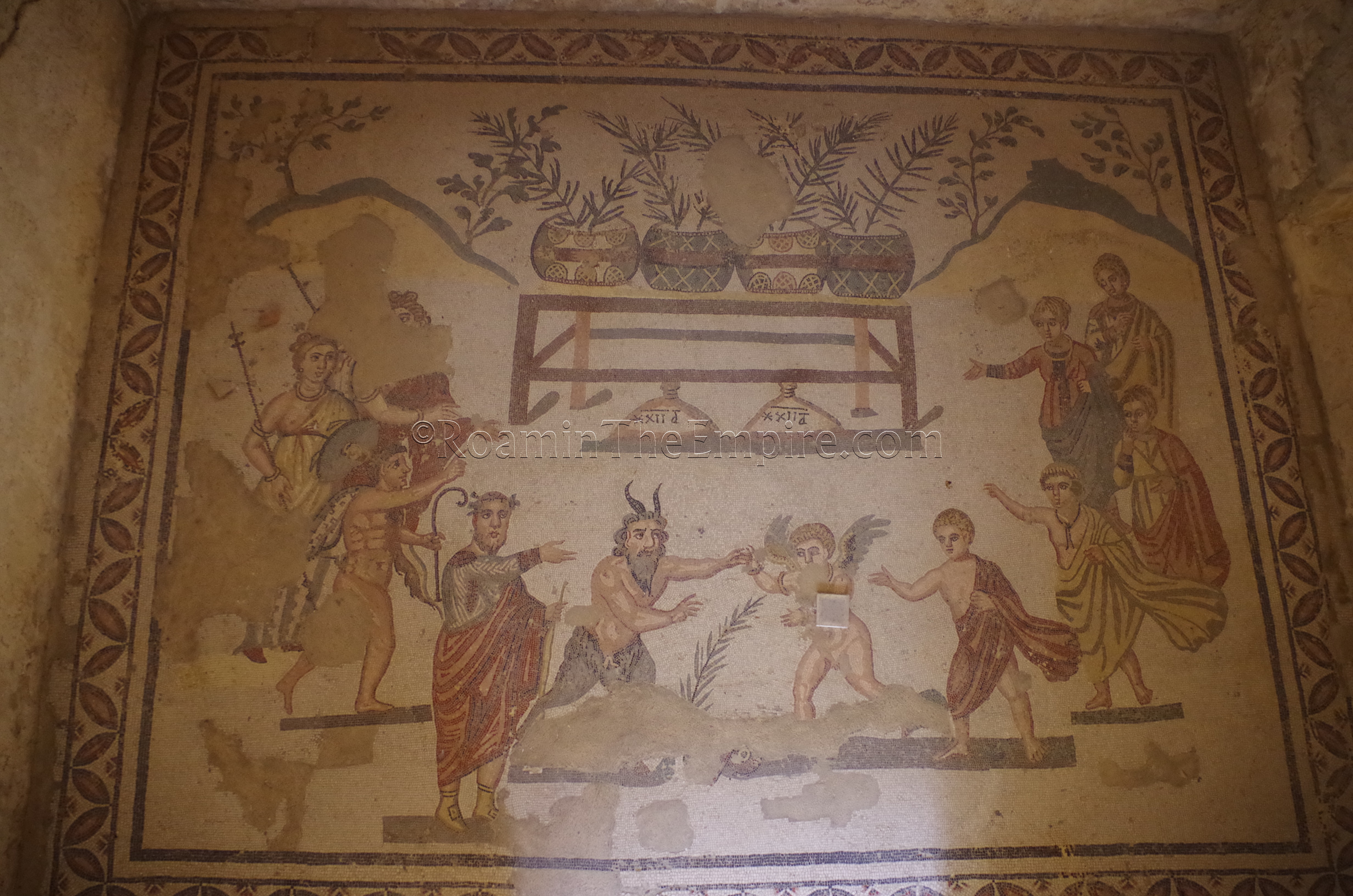
The large complex has everything one might expect out of a villa, and more. There’s a large, monumental entrance to the villa that also serves as the current starting point for the itinerary through the villa. The monumentality of this entrance, incidentally, has also been sometimes cited as another piece of evidence that the owner of the villa was a member of the imperial family. Not only does the monumentality add to this idea, but a partially extant wall painting here has been interpreted as portraits of either the emperors of the first tetrarchy or members of Constantine’s family. There is a bathing complex adjacent to the entry area, though it is not quite as accessible as other areas of the villa. The Circus Maximus mosaic in the two-apse room of the baths, for example, can only be viewed from one end, giving a rather limited view of the interesting scene. Unlike most of the rest of the villa, which uses raised platforms above the walls to give better views of the mosaics in confined rooms, this isn’t implemented in the bathing complex.
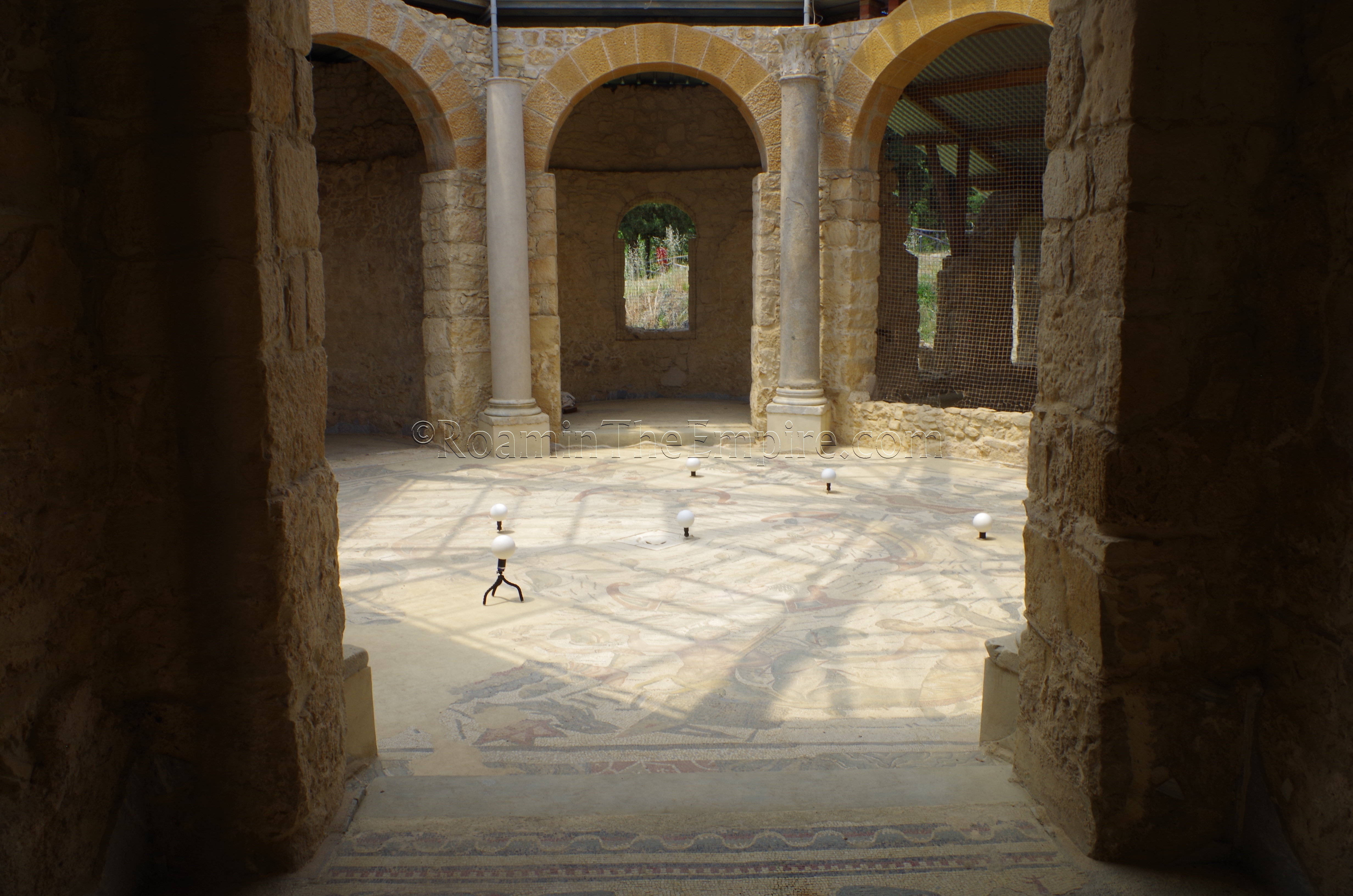
Aside from the bathing complex and entry at the beginning, which is a little more open, the rest of the villa is largely visited on a set path guiding visitors through each of the areas of the remainder of the villa. As I mentioned before, most of this is raised up above the level of the walls, giving visitors the opportunity to look down on the mosaics without any kind of obstruction (which is apparently how it was done before the renovation). Both of these allow for a better overall view of the villa, and avoid the sometimes confusing labyrinthine structure of larger Roman villas, where seeing every room of consequence is often a little easier said than done.
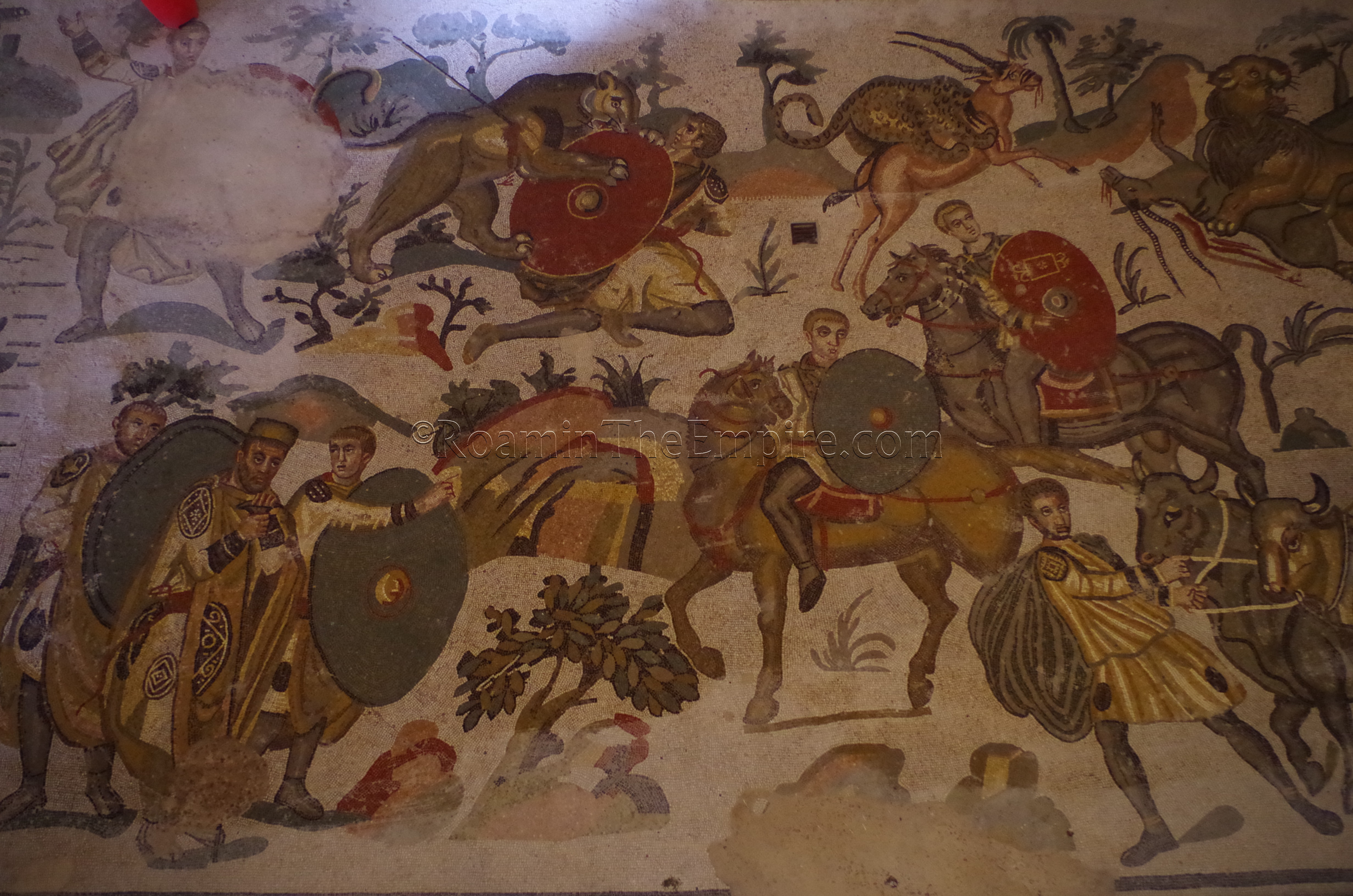
Unfortunately, when I visited, the triclinium was closed, though the ovoid peristyle and adjacent rooms were open for viewing. There wasn’t really much information, but, it didn’t look to be a very temporary closure, and was perhaps related to ongoing restoration works in that portion of the villa. Everything else seemed to be open and viewable, though. In short, the mosaics lived up to their reputation and then some. The level of conservation of most of the mosaics is quite exceptional; it seemed in some areas that they were regularly cleaned through the day to keep them vibrant and colorful; the contrast between the mosaics in the main part of the villa and, say the baths, where there was not the same sort of access allowing for that cleaning, was noticeable. The roofing in the main part of the villa was also ideal as it, for the most part, kept the light on the mosaics even, adding to the aesthetic. In areas where this wasn’t the case, such as in the auxiliary rooms of the ovoid peristyle the difference was, again, quite noticeable.
Informational signs are posted in Italian and English at nearly every room and point of interest. In addition to giving information about the function of the room and its context and location within the Villa Romana del Casale, there would also be informational signs regarding the content of the mosaics.
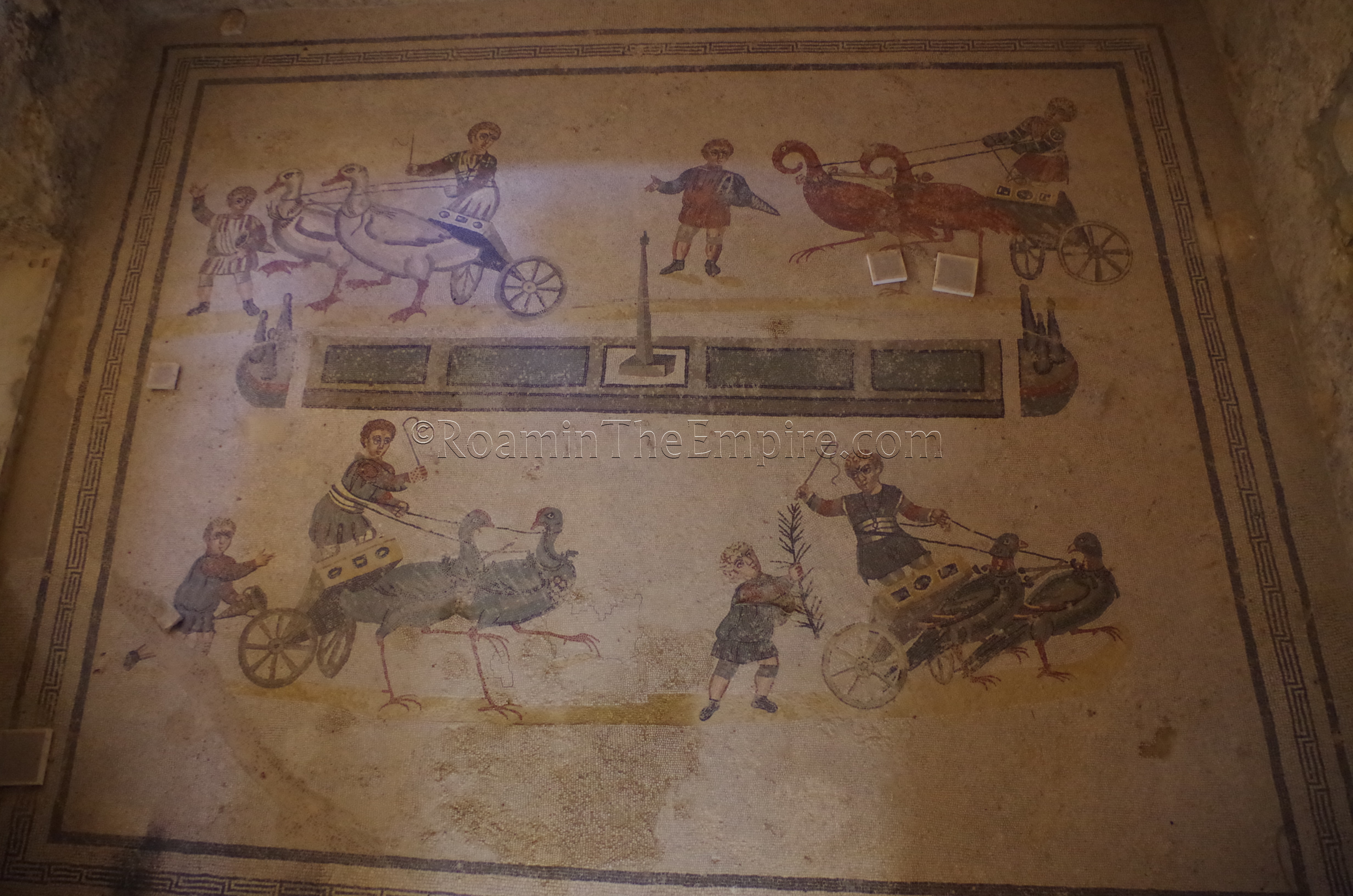
The Villa Romana del Casale is really not to be missed. The collection of mosaics is unique within the Roman world on a number of levels, and any pictures, including those I’ve included here, simply don’t do it justice. It is a bit out of the way of the coastal routes through Sicily where many of the other points of interest are, but, the trip here is well worth the trouble. It took me a little over an hour to get through the entirety of the villa, and honestly, I could have probably spent two hours there, easily. However, as was often the case during this part of my time in Sicily, there was a little bit of a schedule to keep, and having to see the archaeological museum in Agrigento that morning, rather than the previous afternoon as planned, kind of put the crunch on time. It’s quite popular, so, certainly expect a crowd in the summer. I happened to be there on a Saturday, so perhaps it was a little busier than usual, but, I also wasn’t quite there during the high tourist season either. While the narrow walkways do bunch up in some places, it’s more than worth the trouble and certainly shouldn’t deter any potential visitor in the least. The raised walkways have the added bonus of taking crowd obstruction mostly out of the equation.
Sources:
Polzer, Joseph. “The Villa at Piazza Armerina and the Numismatic Evidence.” American Journal of Archaeology, vol. 77, no. 2, Apr. 1973, pp. 139–150.
Smith, Christopher John. Sicily from Aeneas to Augustus: New Approaches in Archaeology and History. Edinburgh Univ. Press, 2007.
Stillwell, Richard, William L. MacDonald, and Marian Holland. McAllister. The Princeton Encyclopedia of Classical Sites. Princeton, NJ: Princeton U Press, 1976.
Wilson, R. J. A. “Roman Mosaics in Sicily: The African Connection.” American Journal of Archaeology, vol. 86, no. 3, July 1982, pp. 413–428.


